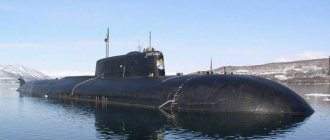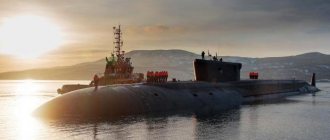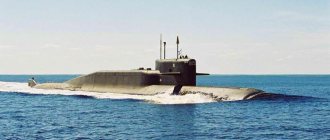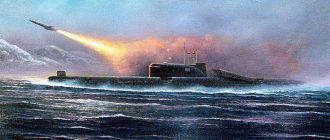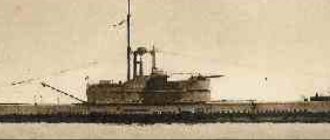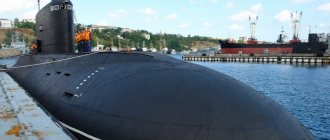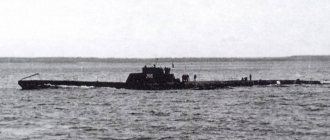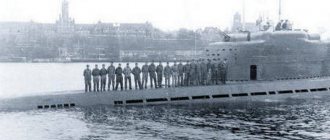History of Russian submarine forces
In world history, Russia has always been listed as a military power. Over the course of many decades, it has been increasing its combat power, both on land and in the sea.
Information: in 1903, the first submarine appeared in Russia.
Russia continues to expand its Navy, adding new submarines that allow it to expand its range of capabilities.
First projects
The history of the Russian Navy dates back to the distant 18th century. It was at that time that a Russian engineer, who mastered this difficult profession on his own, made a drawing of a ship capable of sailing underwater. In appearance, this design resembled a barrel. To make it, copper sheets and boards were required.
The idea of creating such a vessel remained unrealized. Only a century after these events, a submarine was launched, which was supposed to be used for military purposes. It was equipped with a rocket and a mine.
Towards the end of the century before last, work was carried out on submarines that significantly surpassed the original versions. These include the submarine "Dolphin". She was immersed in water in 1903.
During the First World War, the Russian fleet actively used submarines in battles with opponents. At that time, the country had only 75 submarines. In World War II, the fleet already consisted of 212 units of such boats.
“Made with us” and on Yandex.Zen
I bring to your attention a photo review of all the submarines in service and under construction for the Russian Navy.
Project 636.3 “Varshavyanka”:
1. Project 636.3 submarine “Varshavyanka” B-261 “Novorossiysk”. Joining the fleet - 2014. Displacement - 3950 tons.
2. Project 636.3 submarine “Varshavyanka” B-237 “Rostov-on-Don”. Joining the fleet - 2014. Displacement - 3950 tons.
3. Project 636.3 submarine “Varshavyanka” B-262 “Stary Oskol”. Launched in 2014. Displacement - 3950 tons.
4. Project 636.3 submarine Varshavyanka B-265 Krasnodar. Laid down - 2014. Displacement - 3950 tons.
5. Project 636.3 submarine “Varshavyanka” B-268 “Veliky Novgorod”. Laid down - 2014. Displacement - 3950 tons.
6. Project 636.3 submarine “Varshavyanka” B-271 “Kolpino”. Laid down - 2014. Displacement - 3950 tons.
7. Diesel-electric submarine of project 677 “Lada” B-585 “St. Petersburg”. Renamed in February, re-mortgaged in March under the name Entry into the Fleet - 2010. Displacement - 1760 tons.
8. Project 677 diesel-electric submarine Lada B-586 Kronstadt. Laid down - 2005. Displacement - 1760 tons.
9. Project 677 diesel-electric submarine Lada B-587 Velikiye Luki. Laid down - 2006. Displacement - 1760 tons.
- All diesel submarines of the Russian Navy. Photo review
Project 877 "Halibut":
10. Project 877 diesel-electric submarine Halibut B-260 Chita. Joining the fleet - 1981. Displacement - 3040 tons.
- All diesel submarines of the Russian Navy. Photo review
11. Diesel-electric submarine of Project 877 “Halibut” B-227 “Vyborg”. Entry into the fleet - 1982. Displacement - 3040 tons.
12. Diesel-electric submarine of Project 877 “Halibut” B-401 “Novosibirsk”. Joining the fleet - 1984. Displacement - 3040 tons. Status: in storage.
13. Diesel-electric submarine of Project 877 “Halibut” B-402 “Vologda”. Joining the fleet - 1984. Displacement - 3040 tons.
14. Diesel-electric submarine of Project 877 “Halibut” B-808 “Yaroslavl”. Joining the fleet - 1988. Displacement - 3040 tons.
- All diesel submarines of the Russian Navy. Photo review
15. Diesel-electric submarine of Project 877 “Halibut” B-445 “St. Nicholas the Wonderworker”. Joining the fleet - 1988. Displacement - 3040 tons.
- All diesel submarines of the Russian Navy. Photo review
16. Project 877 diesel-electric submarine “Halibut” B-394. Joining the fleet - 1988. Displacement - 3040 tons.
- All diesel submarines of the Russian Navy. Photo review
17. Diesel-electric submarine of Project 877 “Halibut” B-871 “Alrosa”. Entry into the fleet - 1989. Displacement - 3950 tons. Status: under repair.
18. Diesel-electric submarine of project 877LPMB "Halibut" B-800 "Kaluga". Entry into the fleet - 1989. Displacement - 3040 tons.
19. Diesel-electric submarine of Project 877 “Halibut” B-459 “Vladikavkaz”. Entry into the fleet - 1990. Displacement - 3040 tons. Status: under repair. Launched.
20. Diesel-electric submarine of Project 877 “Halibut” B-471 “Magnitogorsk”. Entry into the fleet - 1990. Displacement - 3040 tons.
21. Diesel-electric submarine of Project 877 “Halibut” B-464 “Ust-Kamchatsk”. Entry into the fleet - 1990. Displacement - 3040 tons.
22. Diesel-electric submarine of Project 877 “Halibut” B-494 “Ust-Bolsheretsk”. Entry into the fleet - 1990. Displacement - 3040 tons.
- All diesel submarines of the Russian Navy. Photo review
23. Diesel-electric submarine of Project 877 “Halibut” B-177 “Lipetsk”. Entry into the fleet - 1991. Displacement - 3040 tons.
- All diesel submarines of the Russian Navy. Photo review
24. Project 877 diesel-electric submarine “Halibut” B-187. Entry into the fleet - 1991. Displacement - 3040 tons. Status: under repair.
25. Diesel-electric submarine of Project 877 “Halibut” B-190 “Krasnokamensk”. Entry into the fleet - 1992. Displacement - 3040 tons.
- All diesel submarines of the Russian Navy. Photo review
26. Project 877 diesel-electric submarine Halibut B-345 Mogocha. Entry into the fleet - 1994. Displacement - 3040 tons.
Project 877EKM
27. Project 877EKM diesel-electric submarine B-806 “Dmitrov”. Joining the fleet - 1986. Displacement - 3040 tons.
Project 641
28. Diesel-electric submarine B-380 “Saint Prince George” of project 641B “Som”. Entry into the fleet - 1982. Displacement - 4600 tons.
- All diesel submarines of the Russian Navy. Photo review
29. Diesel-electric submarine of project 641 “Zaporozhye”. Joining the fleet - 1970. Displacement - 2550 tons. Status - in 2014 it was captured from the Ukrainian army. Currently unofficially in the Black Sea Fleet reserve. They officially promise to return it to Ukraine after the end of the civil war.
Project 2012030
Project 20120 diesel special purpose submarine B-90 Sarov. Joining the fleet - 2008. Displacement - 3950 tons.
Types of submarines
The nuclear submarine, project 941 "Shark", is capable of diving to a depth of half a kilometer and maintaining a combat watch for 6 months.
Submarines are usually divided into separate types, differing in armament and design. Each such vessel is designed to perform a specific task.
The Russian Navy is based on four types of submarines:
- Nuclear submarines equipped with ballistic missiles.
- Multipurpose nuclear submarines with cruise missiles.
- Attack diesel electric submarines.
- Nuclear submarines with cruise missiles.
Russia is known for building its own submarines of all major classes.
Nuclear submarines
Nuclear submarines are usually equipped with torpedoes and cruise missiles.
The main task of nuclear submarines (nuclear submarines) is to destroy underwater, coastal and surface objects that pose a threat.
The most powerful submarine of this type is considered to be the Shchuka-B. This is project 971.
In total, Russia has 11 nuclear submarines. They are located within the Pacific and Northern fleets. 5 of them were forced to undergo repair work.
Technical and tactical characteristics
The following are documented:
- crew – more than 50 people;
- displacement 2,325 tons (surfaced), 3,076 tons (submerged);
- length – up to 75 –;
- width – up to 10 –;
- draft – up to 7 –;
- power plant - one shaft, 2 diesel engines with a capacity of 3.65 thousand l/s and an electric motor - 5.9 thousand l/s, as well as 2 backup electric motors of 102 l/s;
- movement speed – up to 10 knots on the surface and up to 19 – underwater;
- cruising range - up to 7 thousand miles at a speed of 8 knots per hour under RPD (at periscope altitude) and up to 460 miles in a submerged position at a speed of 3 knots per hour;
- navigation autonomy – 45 days;
- immersion depth – up to 0.33 km;
- armament - 6 vehicles loaded with eighteen torpedoes or 6 more in the number of mines, 4 missile launchers (cruise missiles with a range of 0.5 thousand km) and short-range surface-to-air air defense systems (8 missiles). Various modern electronic equipment for detecting targets and maintaining their own stealth.
Interesting! The guides for the main shaft are made... of wood! Truly a special tree. It is a buckout native to Central America. It is very hard (1.3 thousand kg/m), saturated with guaiac resin, very wear-resistant, with natural lubrication. These indicators enable the shaft to serve for a couple of decades.
Weapons and features of nuclear submarines
The number of nuclear submarines at the disposal of the Russian Navy is constantly increasing. Ballistic missile submarines are now among the most important in the fleet. They are distinguished by excellent secrecy, due to which they are able to successfully hide in the World Ocean.
Submarines of this type are currently available only in countries that are members of the “nuclear club.” This is influenced by a number of important factors. These include the complexity of creating a submarine and the peculiarity of their work in battle.
Ballistic missile submarines
The nuclear submarines of the Russian Navy include submarines equipped with ballistic missiles. Prominent representatives of this type were K-44 “Ryazan” and K-18 “Karelia”.
K-44 "Ryazan" is a nuclear submarine cruiser. The Pacific Fleet is considered to be its home base. The nuclear submarine was laid down in the winter of 1980. It was launched into the water only in 1982. The submarine received its name only 6 years after this event.
Another powerful submarine cruiser is the K-18 Karelia. It belongs to project 667BDRM "Dolphin". This is a representative of the second generation of boats. Karelia is based in Gadzhievo (Northern Fleet).
"Underwater" confrontation between two superpowers
Diesel-electric submarines actively participated in the confrontation between the USSR and the USA, at that time two world superpowers, including in the “Carribean” crisis, which almost plunged the globe into the third world war, but already a nuclear-atomic war. Fourth Bukashki took part in Operation Kama, including Chelyabinsk Komsomolets. Their task, when attacking our merchant ships transporting missiles with nuclear warheads to Cuba, was to strike the American fleet. In the Atlantic, diesel submarines of the USSR found themselves in a storm they had never seen before, but the equipment and people survived. The second test, worse than the first, came with going to the site of possible military operations: the heat in the boats was more than 50 degrees Celsius. At the same time, water was provided on an extremely limited basis - one glass per day per person. This project was designed for combat operations in northern latitudes, and not at the equator. The politicians managed to come to an agreement and a military conflict did not take place, and subsequently many additions, including radical ones, were made to the design of long-range diesel-electric submarines.
During the Cold War, submarines operated covertly off the coast of a potential enemy, sailing autonomously for up to three months. There is a known case when, without entering the coastal waters of Italy, our submarine determined its location by the release of the anchor by the US aircraft carrier Nimitz. And the Project 705 nuclear submarine followed the NATO warship for almost a day, despite all its attempts to “throw” it off its “tail,” and stopped the pursuit only after receiving the appropriate order.
Invaluable experience
It must be admitted that in Soviet times there was a strong bias towards the construction of naval personnel to the detriment of the creation of infrastructure for the basing system. As a result, ships stood in clusters at the berths and their systems wore out ahead of time. The short service history of Project 705 submarines was characteristic. These were the fastest submarines in the history of the world fleet. Small, heavily armed and highly automated boats became a sensation in the 1970s and 1980s. But they were based on a liquid metal coolant reactor. Unfortunately, problems with onshore maintenance of such reactors led to a very short service life of this miracle of domestic shipbuilding. And the general underdevelopment of the coastal basing system led to the massive withdrawal from the fleet in the 1990s of a large number of ships and submarines that could serve in our time.
Harbor
Russian submarines in the Syrian port of Tartus
Photo: IZVESTIA/Alexey Ramm
Into the icy ceiling: the submarines will break through the hole for a rocket to surface
New ammunition will destroy any hummocks
It was with this sad experience in mind that when creating a new generation of submarines, the Navy command began with the development of a full-fledged support system for them, both ground and surface.
The first stage of work in Vilyuchinsk has already been completed. On the second, about a million cubic meters of soil will have to be removed. In essence, a completely new base will be created.
A significant amount of work to create a base was also carried out in Syrian Tartus. Whereas this remote military installation was previously looked after by four men and a dog, it is now a full-fledged naval base that can house both nuclear and non-nuclear submarines.
